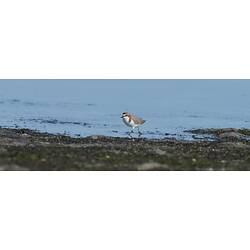General Description
Red-capped Plovers are grey-brown above with white underneath and on the forehead. Their bill and legs are black. Adult males have a bright reddish-chestnut nape (back of neck) and crown, with a black stripe running from the bill to the eye and one running from the nape to the breast. Adult females have a grey-brown crown, a pale red-brown nape and less distinct black markings. Bill to tail length is up to 16 cm.
Biology
Red-capped Plovers are beach-nesting birds. They lay their eggs in a shallow depression close to the water. The eggs are extremely well camouflaged and can be accidently crushed by beach users including humans, animals and vehicles. The birds are very susceptible to disturbance during the breeding season, often meaning that the eggs fail to hatch or chicks don't survive. When the nest is threatened, Red-capped Plovers will attempt to distract the intruder, including faking a wing injury to lead predators away. To help protect the nests and young, some beaches cordon off nesting areas while the birds are breeding, and beach users can help by keeping dogs on leads and staying outside fenced areas. Red-capped Plovers are usually seen on the beach running along the edge of the water using a distinctive 'stop-run-peck' foraging method. They feed on small crustaceans, molluscs, other invertebrates and some vegetation.
Distribution
Mainland Australia and Tasmania.
Habitat
Sandy beaches, saltmarshes, and saline wetlands and lakes.
More Information
-
Animal Type
-
Animal SubType
-
Brief Id
A small, common beach-nesting shorebird with grey-brown wings, a white belly and a black face stripe.
-
Colours
Brown, White, Red
-
Maximum Size
16 cm
-
Habitats
-
Diet
Omnivore
-
Diet Categories
Molluscs, Crustaceans
-
Endemicity
-
Conservation Statuses
CITES: Not listed, FFG Threatened List: Not listed, EPBC Act 1999: Not listed, IUCN Red List: Least Concern
-
Taxon Name
-
Common Name
Red-capped Plover
-
Kingdom
-
Phylum
-
Subphylum
-
Class
-
Order
-
Family
-
Genus
-
Species Name
ruficapillus







